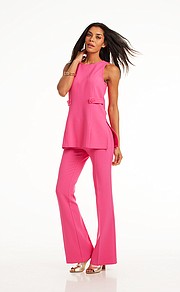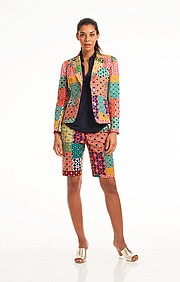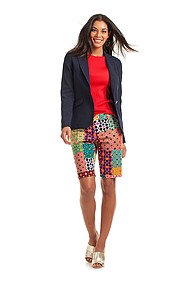RETAIL
Trina Turk Marches Forward With New Store and New Looks
Trina Turk, the contemporary lifestyle designer known for her bright colors and mid-century–inspired prints evoking a resort vacation, is opening her 12th store next February in the Larchmont Village area of Los Angeles.
The new space comes nearly two years after shuttering her outpost on West Third Street, where parking had become impossible and traffic congestion was chipping away at sales of her self-named label.
“Since we are an LA-based brand, it seemed weird not to have a store in Los Angeles,” said the designer, who currently has retail locations across the United States in places such as Miami, Dallas, Houston, Atlanta, New York and Newport Beach, Calif.
Turk, whose company was launched in 1995, is a true believer in retail if it provides shoppers a reason to peek beyond the front door.
“Our mantra in our own stores is that we must provide our customers with something better. Otherwise, why should they come in? They have to have fun and have a sales associate who knows them and understands them,” the designer told a group gathered at the Los Angeles Chamber of Commerce on Oct. 31 for a “Power Hour” lecture on “How to Build an Empire With Trina Turk.”
Retail has morphed drastically since the Trina Turk brand opened its first store in Palm Springs, Calif., nearly 15 years ago. Few people were shopping online and sites like Revolve Clothing, Nasty Gal and Net-a-Porter didn’t even exist.
But that Palm Springs store has expanded twice and is the No. 1 store in the Trina Turk retail lineup. “Our brand is an optimistic brand. We are Californians, and California is an optimistic place. It is important to give off this vibe in the story of positivity,” she said. “The landscape is changing rapidly, but I still think people will come into retail stores if it is fun.”
Still, the label has its own e-commerce site as well as selling to high-end department stores and boutiques such as Nordstrom, Neiman Marcus, Saks Fifth Avenue and Bloomingdale’s, which also sell Trina Turk’s fashion on their online locations.
Even in 2001 it was a gamble to take a chance on retail. Turk said she and her husband and business partner, Jonathan Skow, signed that first Palm Springs retail lease on Sept. 10, 2001, one day before the 9/11 terrorist attacks on the East Coast. “We really didn’t know much about retail, but we were okay because the rent wasn’t that expensive,” she said. “The worst-case scenario was we would create this great showcase for our clothing. And then it was like, ‘Oh, that may not have been a really great idea.’ But Palm Springs in a way seemed so far removed from the events in New York.”
The store did not start with a bang but built up slowly to the point that the Trina Turk location now takes up a row of stores on Palm Canyon Drive and has been part of every news story written about the rebirth of Palm Springs, which declined considerably after luxury developments began rising in nearby Palm Desert, Calif.
Keep it moving
After 12 years working as a designer for clothing companies such as Ocean Pacific and B.U.M. Equipment, Turk felt she had enough experience to start her own line, which was launched out of the spare bedroom in her house.
The vivid prints and bright colors she had grown used to as a designer in the surfwear and sportswear industry became the DNA of her label, whose dresses sell for $200 to $400 and tops go for $100 to $250.
“I knew about design and merchandising and a little about wholesale sales, but there was a whole back-end part of running that business I knew nothing about. Every other day, for the first year, something would come up,” she recalled.
People would ask if she had a factor, which provides financing to apparel makers using their accounts receivables as collateral. “I said, ‘Why do I need a factor?’”
Someone else would ask if she had a freight forwarder, and again she asked why. But using a network of friends she had developed over the years, she got help.
That first season, she took her Los Angeles–sewn samples to New York to find a showroom. “I schlepped the line around the garment center in New York and showed to multi-line showrooms, and at the end of the week there were three that were interested,” she recalled, saying she left the samples behind with the showrooms. Then she found a Los Angeles showroom.
Her first collection for the Holiday 1995 season had only about 20 pieces, but she got orders from Barneys New York, Saks Fifth Avenue and Fred Segal. She personally took the line to the American Rag Cie store in Los Angeles, which also placed orders.
Then the Bebe chain of stores placed a $250,000 order and she was up and running. “I thought, ‘Oh my God, how am I going to make this happen?’ I was going to make everything in Los Angeles, but that was a huge order.”
With her years of experience producing clothing in China for OP and B.U.M. Equipment, she contacted her overseas factories and got her Holiday collection made in time for delivery.
“Fortunately, it was silk, which China does. The money from that order got us off the ground,” she said.
Still, Turk said she is committed to making as much as she can in Los Angeles and still manufactures 40 percent to 50 percent of her collection in Los Angeles. While her profit margins are higher than most, it is still necessary to do labor-intensive styles overseas. But Turk recently added a cut-and-sew space next to her large headquarters in Alhambra, Calif., to accommodate more local production.
Of course, there have been bumps along the way. Turk and her husband had a third partner, who was becoming more reticent about growing the business. They wanted to buy her share of the company, but this was more than 10 years after the label had launched, and it would take more money than they had to take over her ownership.
So Turk and Skow met with The Sage Group, the Los Angeles investment bank known for several big-name apparel purchases, which shopped the company around to various private-investment firms. In July 2008, KarpReilly LLC, based in Greenwich, Conn., bought their partner’s share of the company as well as some shares owned by Turk and Skow. “So far, they have been pretty hands off,” Turk said.
The timing was fortunate. Within months, the U.S. economy would be headed on a downward slope for more than a year, creating what everyone refers to as the Great Recession. It was a real game changer for the retail industry.
“The downward spiral of pricing really started in 2008,” Turk remembered. “In 2008 and 2009, a lot of stores wanted us to make cheaper clothes and reduce our price points. But the whole point of our brand is that we were not fast fashion and we were not throw-away fashion. We were using fabrics like silk and not polyester. During that time, people were asking us to knock ourselves off. We decided not to do that and that has solidified us where we are as a brand today. Sticking to our quality and price points was wise and important at that time.”
The recession made life challenging. It took the contemporary label nearly three years to recoup the revenues it had before the economic decline started.
Today, Turk doesn’t know if she could have the same success starting a contemporary label as she did in 1995. “I think the store buyers were more open then to coming to Los Angeles. Now things are more corporate, and I don’t know if stores would be willing to take a risk on some new brand,” the designer said.
She has grown her label, whose revenues were predicted to reach $100 million in 2014, by keeping the brand alive with new fabrics, prints and colors that keep changing as do the silhouettes. “Fabric technology is always evolving,” she said. “The fabric tells you what it wants to be and it is easy to update the brand and keep it going.”
In recent years, the company has added Mr. Turk, a menswear collection designed by Skow, who is also a photographer and stylist, and signed several licenses to make handbags, jewelry, swimwear, shoes and, most recently, sunglasses and prescription eyeglass frames.
This year, Turk and her husband partnered with Disney Pixar and developed ready-to-wear and swimwear collections to coincide with the release of the animated film “Finding Dory.”

























